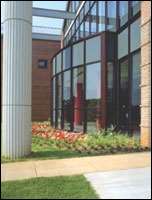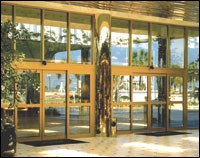The Specifics of Architectural Anodizing
Specifying anodized finishes for architectural aluminum—the Southern Aluminum Finishing way…
In 1946, Southern Aluminum Finishing (SAF) began work on its first anodizing line. Four years later, the family-owned company ventured into the architectural field selling aluminum sheet and extrusions with and without anodized finishes. In the 53 years since, architectural aluminum and the finishes applied to it are probably SAF’s strongest markets.
SAF’s long history within the architectural and anodizing markets has allowed it to grow and develop along with these markets. It has developed standards for finishing architectural aluminum that can be used in most anodizing shops and are often specified by builders and architects. The SAFINISH Designation System is what SAF uses for specifying exterior finishes used on architectural aluminum building products. “A SAFINISH has the longest expected lifetime of any available finish for architectural aluminum,” noted Penn McClatchey, vice president. “These finishes are only available on aluminum, because aluminum is the only metal with the longevity and corrosion resistance equal to the quality implied by the SAFINISH designation.
Featured Content
“It doesn’t make sense to apply an inferior aluminum finish to cut costs. An aluminum finish is typically less than 1% of a project’s cost, but it can be 100% of its appearance,” he continued. SAF is so confident in its finishes that it offers 5- and 20-year limited warranties on them.
So, how do you specify the right finish for architectural aluminum? Not only is there anodizing, but you can also choose from paint and powder coating. SAF supplies all three finishes, but offers consumers the benefits and shortcomings of each coating, depending on the final architectural application.
Basically, What Is Anodizing?
Anodizing is a simple electrochemical process developed more than 50 years ago. It forms a protective coating of aluminum oxide on the surface of the aluminum. The lifetime of the finish is proportional to the thickness of the anodic coating.
The coatings have been historically developed from either a chromic acid or sulfuric acid bath. Sulfuric acid anodizing is probably the most commercially important, since it can produce coatings in a range of thicknesses. These coatings can also be dyed. Chromic acid anodized surfaces are also porous and, therefore, able to be dyed. There are advantages to sulfuric acid anodizing over chromic acid anodizing. These include:
- Less expensive with respect to chemicals used, heating, power consumption and length of time needed to obtain the desired thickness
- More alloys can be treated
- Coatings are harder
- It is a clearer coating that permits dyeing with a greater variety of colors
- Waste treatment is simpler
There are, however, limitations to sulfuric acid anodizing. These include: - Reduction of the fatigue characteristics of the alloys
- Difficult to control when small dimensional changes are required, since the coating grows more quickly than a chromic acid anodize
- Solution may remain in recesses and other areas, causing corrosion
A chromic acid anodized coating is harder than the base metal; however, it provides limited abrasion resistance because of the low thickness and structure. These coatings do have higher resistance to salt spray corrosion, and very thick coatings of this type are electrically insulating.
There are several advantages to chromic acid anodizing. These include: - Not necessary to remove all traces of residual solution
- Excellent base for organic coatings
- Coatings are thinner but meet the same corrosion resistance requirements as conventional sulfuric acid anodized parts
- Coatings are excellent as maskants for selective hard anodizing applications
Chromic acid anodizing also has its drawbacks compared to sulfuric acid anodizing. These include: - Lower abrasion resistance
- Limited to alloys containing less than 5% copper or 7% silicon
- Higher voltage and more time required
- Cannot anodize alloys in the annealed condition
- Burning may occur
- Waste treatment for hexavalent chromium is required.
Anodizing is controlled using current density. When beginning an anodizing job, the initial voltage should be low and slowly increased. Aluminum oxide is a hard, durable, weather-resistant substance that protects the base metal. The coating may be colored by dyeing or may exhibit bronze tones through diffraction phenomena produced by the coating. The coating grows from the base aluminum metal through this electrochemical process. The coating is integral to the metal and cannot peel or flake. The structure of the coating is many small hexagonal pores that are filled with a seal that hydrolyzes them to fill them with inert aluminum oxide.
Hard anodizing or Type III is different from Type I or Type II anodizing with typical chromic or sulfuric acid based solutions. Hard anodizing uses sulfuric acid, additives, a lower temperature, higher current density, vigorous agitation and produces heavier coatings. The coatings exhibit excellent corrosion resistance; however, chemical resistance is not good. Cracking or crazing may result as the temperature increases to ambient temperature or higher sealing temperatures. Since sealing reduces hardness by as much as 60%, hard anodized coatings should not be sealed if maximum corrosion resistance is required. Flaking or chipping can occur at temperatures above 200-300C. There is very little of this type of coating used in architectural applications.
In general, anodizing is less expensive than painting, with the exception of coil-coated products. Anodizing is harder than PVDF and better for aluminum in high traffic areas where the coating is subject to physical abuse and abrasive cleaners. Anodizing gives aluminum a deeper, richer metallic appearance than is possible with organic coatings, because an anodized coating is translucent, allowing the base metal to show through the coating. This translucence contributes to color variation problems, but SAF uses computerized color matching with quantitative, objective color data to overcome this problem. Anodizing is unaffected by sunlight, making it perfect for outdoor architectural applications. Unlike organic coatings, it will not fade due to ultraviolet light.
Anodizing and the Environment
Anodizing is compatible with today’s environmental concerns. However, more research needs to be done to determine the total environmental impact of different aluminum finishes. The chemicals from anodizing can be used by municipal wastewater treatment facilities. The aluminum sulfate from anodizing plants’ effluent actually improves the solids settling efficiency of some wastewater treatment plants. There are no heavy metals involved in the process.
Curtain Walls and Metal Roofing
When a live, translucent building exterior is desired, anodizing is a good finish for a curtain wall. Architects should require color range panels from the anodizer. The installer should be aware of the variability expected from anodized panels. An installer may be able to sort some of the panels by elevation for a desired effect. If a panel is outside the approved color range, the finisher should not ship it. However, SAF feels it is also the installer’s responsibility to avoid installing metal that is not within range.
“This is why we recommend the SAFINISH (Aluminum Association Class I). This makes the anodic coating as durable as possible. Coating thickness is one of the most significant indicators of durability for anodized coatings,” noted Mr. McClatchey. “Coating thickness for architectural use can be specified as either Class 1 (0.7 mil) or Class 2 (0.4 mil) per the Aluminum Association DAF 45, but often there is no specification. The ‘cheapest priced’ piece is then installed, and in a few years the finish is pitted, stained and eroded. Inexpensive anodized sheets are often sold with a coating thickness of 0.1 mil.”
|
||||
A finish with a thickness of 0.1 mil is known as a 200, A21, A22 or A24 finish. This coating thickness is suitable for many applications; however, the integrity of this finish will not last more than a few years in exterior architectural applications, and even less in coastal regions. Also, because it is a thin coating, there is less color agent, which will cause it to fade more quickly.
Cleaning can renew anodizing; however, little can be done if the coating has failed. Both anodized and painted surfaces require regular maintenance, which is something building owners need to consider. Often, masonry contractors use acid to pressure wash the bricks or concrete. Any of this that washes over onto an anodized surface could destroy it.
Storefront
Kickplates, door handles, door stiles and push/pull bars should be anodized, since the abrasion resistance will outlast any painted surface.
Whatever type of anodized finish is chosen depends on the end use. Anodizing is best suited to storefronts and anywhere else a rich metallic appearance is desired. Anodized and polyester coatings are best for storefront and handrails. Anodized, PVDF and polyester coatings could all be used on curtain wall, roofing and storefront applications.





















